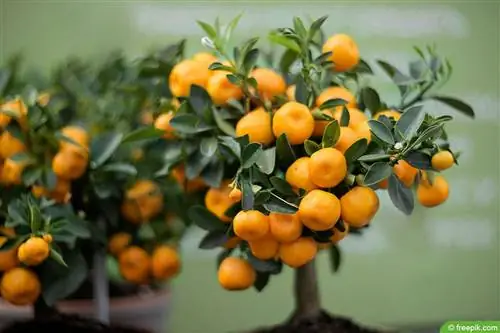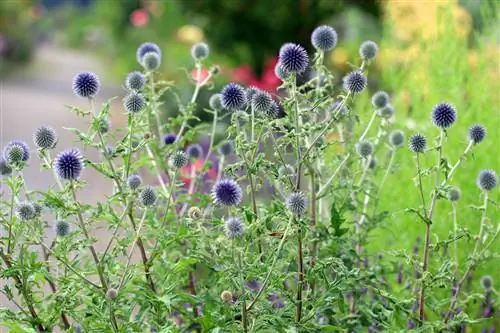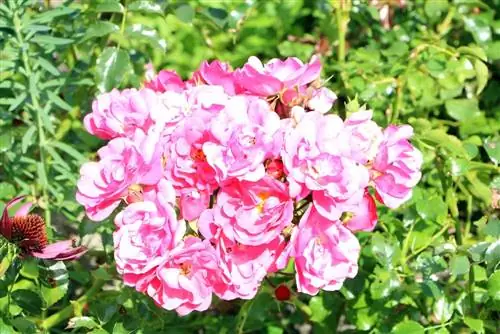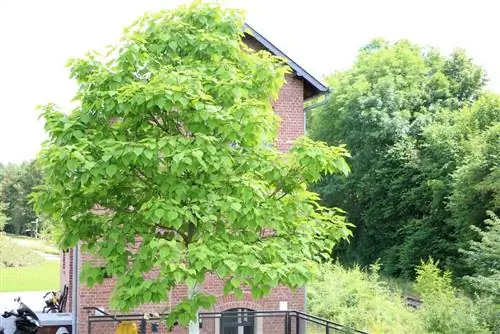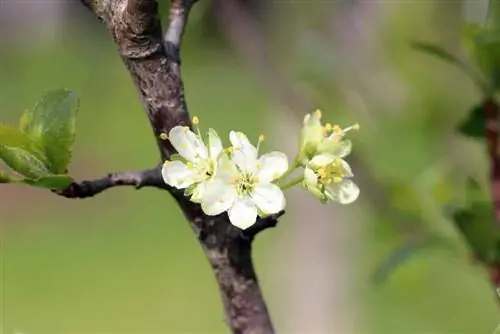- Author admin [email protected].
- Public 2023-12-17 03:39.
- Last modified 2025-01-24 12:45.
Mandarins are not only popular at Christmas time, they also spread a Mediterranean flair in summer. All the better if you can grow them yourself and then harvest your own fruits.
Profile
- Plant family: Rutaceae
- Botanical name: Citrus reticulata
- German name: Mandarin tree
- Growth: upright, dense, bushy, shrub or small tree
- Growth height: 150-400 cm
- Foliage: dark green, lanceolate, elliptical
- Flower: white, fragrant individual flowers
- Flowering period: May-September
- Toxicity: not poisonous
- Lime compatibility: lime tolerant
Site conditions
Like all citrus plants, the mandarin tree loves warm climates with lots of sun, especially in the morning and evening. Blazing midday sun can heat up the root area too much and the roots can no longer compensate for the water loss from the leaves.
- also avoid drafts and major temperature fluctuations
- location that is too dark leads to leaf loss
- as well as for the formation of long, weak horny shoots
- due to lack of frost hardiness, only in containers
- Outdoor location possible in summer
- Initially place in partial shade to get used to it
The plant thrives best in a permeable and slightly acidic substrate. The trade offers special citrus plant soil for this purpose. Or you can mix germ-free garden soil with a little peat and expanded clay, grit or coarse sand.
Pouring
This plant requires a comparatively large amount of water. However, it should not be too dry or too wet. Too much moisture would lead to root rot, which should be avoided.
- Allow the substrate to dry superficially
- remove excess water in the saucer
- preferably water with rainwater
- Allow tap water to stand well
- morning is the best time of day for watering
- ensure increased humidity
- Set up a humidifier and/or spray it
If the plant is outdoors, you should not rely on heavy downpours, as the root area is usually well shielded by the foliage, so that hardly any water penetrates to the ground. Additional watering is therefore essential.
In the first two years of existence, an adequate water supply is particularly important. The quantities can be reduced slightly later.
Fertilize
Young tangerine trees in particular need plenty of nutrients. Older people get by with significantly less. High-quality citrus fertilizers are very suitable for this. They usually contain a lot of nitrogen, little phosphorus and lots of trace elements. Fertilize once a week via irrigation water from May to August. From August onwards there will be no more fertilization.
Wintering
With the right care, the tangerine tree can survive a winter, but there are a few things you should pay attention to.
Time and duration
The tangerine tree should be left outside for as long as possible and put out again as early as possible. Wintering lasts on average from early November to early April. In mild regions such as the Rhineland it often starts a little later and ends earlier. In cold locations such as the low mountain ranges, wintering usually begins at the end of October and lasts until mid-April. As a rule, you bring the plant into the house as soon as the temperatures drop well below ten degrees, but in any case before the first frost.
Tip:
Before putting them away, you should check them for possible pest infestation and remove them if there are any.
Winter quarters
The almond tree can overwinter light and warm or dark and cool. The brighter, the warmer it should be. The maximum temperature is between 10 and 15 degrees. If the thermometer rises to 15 degrees, the plant needs around eight hours of light per day. If necessary, additional plant lamps are recommended. If the winter is rather cool between five and ten degrees, care must be taken to ensure that the bale does not cool down. For example, by placing the bucket on a Styrofoam plate or coconut mat.
Tip:
Frost-free greenhouses, garages, cellars or unheated winter gardens and stairwells are suitable for wintering.
Care in winter quarters
If the conditions in the winter quarters are not optimal, the plant reacts by dropping its leaves. If the wintering is warm and bright, it needs to be watered regularly and fertilized sparingly. Regular ventilation is just as important. On the other hand, if the winter is cool, it only needs to be watered occasionally and not fertilized. The substrate should neither be too wet nor dry out completely. Otherwise, you should leave the plant alone during its resting phase and neither cut, repot nor rotate it.
End hibernation
As soon as the temperatures rise again in spring, the plants can be prepared for being outdoors. It's best to wait for the Ice Saints so that they don't suffer any frost damage. The tangerine tree should not be placed directly in the blazing sun, but should be slowly acclimated to the new conditions to avoid sunburn. It's best to put it in a shady place for the first few days, ideally close to the house and only later in its final place.
Cutting
Between the end of February and mid-March or before budding is also the best time to prune the tree. This cut stimulates more new growth and thus supports the formation of a dense crown. Even if this plant does not necessarily need to be pruned, the more consistently you prune it, the more beautiful and compact it will remain. The main thing is a beautiful crown shape.
- trimming if crown gets out of shape
- remove dried and stunted branches
- as well as all inwardly growing and crossing shoots
- always cut just above an outward-facing eye
- shorten shoots that are too long by a maximum of two thirds
- only use sufficiently sharp and disinfected cutting tools
- Avoid bruises and injuries
- Leave fruit-bearing branches untouched at first
- Seal wounds larger than a 1 euro coin
When cutting you should always be a little cautious and avoid radical cuts, because the tangerine is not very easy to cut. Stunted or dead branches can easily be cut out all year round.
Tip:
Pruning measures are also possible directly after flowering, but should be done promptly because shortly after flowering the buds for the next year are already formed.
Repotting
If the tangerine tree needs to be repotted, for example because the pot has become too small, you should do this after the winter rest around March/April. For younger plants, it is recommended about every two to three years. Older specimens need to be repotted less often. The new pot should be a maximum of four centimeters larger than the old one.
- Equip pot with drainage material
- top it with some of the fresh substrate
- Removing the plant from the old pot
- remove loose soil from the bale
- as well as damaged or dead root parts
- Insert mandarin in the middle
- as deep as in the old pot
- Refining point, if available, should be above ground
- fill with substrate
- Press soil and water
Propagate
There are various ways to propagate a tangerine tree.
About seeds
To obtain seeds, i.e. kernels, you should know the difference between tangerines and clementines. The latter usually have no cores. After you have enjoyed the fruit, you first remove any remaining pulp from the seeds. Then you let them dry on some kitchen paper for about a week. Then you place them in small pots with potting soil and only cover them lightly with soil. The whole thing is moistened and placed in a place that is around 22 degrees warm.
From now on, the soil must be kept constantly moist without being waterlogged. Germination occurs after about a month. Now the seedlings can move to a bright place without direct sunlight. After another six to seven weeks they can be transplanted into a larger pot. It can take up to ten years for a tangerine grown from seeds to bear fruit for the first time.
Tip:
A cover with translucent film can accelerate germination. However, this must then be removed regularly and the whole thing must be ventilated to avoid mold formation and rot.
With cuttings
- Cut cuttings in spring after budding
- about 10-15 cm long head cuttings
- cut below a leaf node
- remove all but the top two or three leaves
- halve remaining leaves to reduce evaporation
- Fill the growing container with low-nutrient growing soil
- Place the cutting briefly in rooting powder
- then plant, press down the soil and moisten it
- Put a translucent foil bag over it
- keep warm and keep the substrate moist
- Root formation occurs after a few weeks
- Remove the film after root formation
- Transplant when appropriate size
Diseases and pests
Diseases and pests can be very hard on a mandarin tree and seriously damage it. If the danger is recognized in time and treated correctly, the mandarin trunk still has a good chance of recovering.
Iron deficiency
Different shades of green in the leaves and prominent leaf veins are often signs of an iron deficiency. The plant now needs nitrogen and should be fertilized accordingly even if no fertilization is actually recommended in winter.
Root rot
If the roots rot, the tree drops its leaves. Then it should be repotted into fresh substrate as quickly as possible. All rotten and damaged root parts are removed. In the future, it is important to ensure watering according to needs.
Spider mites
An infestation is indicated by fine white webs and small white speckles on the leaves. They usually occur when the air in the room is too dry and warm. To combat this, a spray solution consisting of 1 liter of water and 250 ml of rapeseed oil is recommended, which is applied twice a week until the infestation is no longer detectable.
Scale insects
Scale insects can be recognized by small brownish, curved scutes on the leaves. They also occur especially during the cold season due to low humidity. They can be combated, for example, with preparations based on paraffin and rapeseed oil.

